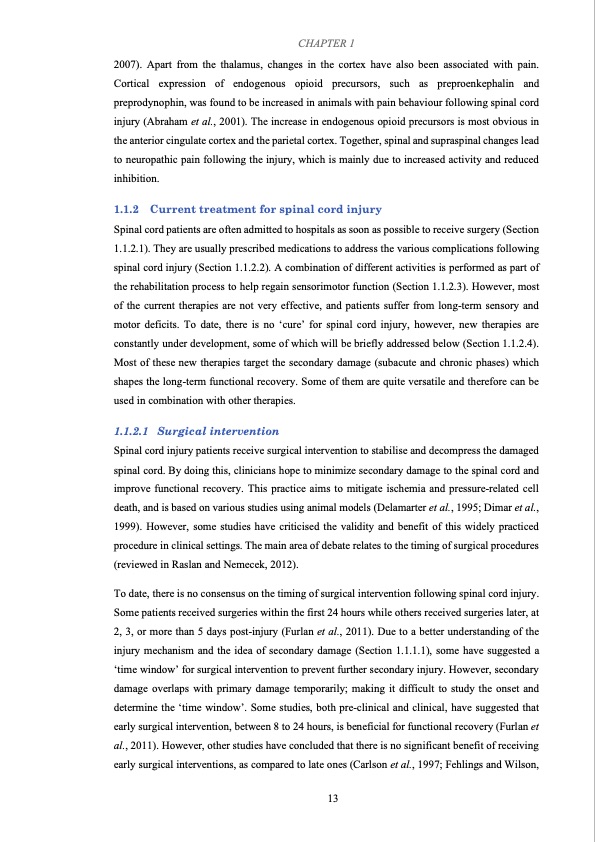
PDF Publication Title:
Text from PDF Page: 027
CHAPTER 1 2007). Apart from the thalamus, changes in the cortex have also been associated with pain. Cortical expression of endogenous opioid precursors, such as preproenkephalin and preprodynophin, was found to be increased in animals with pain behaviour following spinal cord injury (Abraham et al., 2001). The increase in endogenous opioid precursors is most obvious in the anterior cingulate cortex and the parietal cortex. Together, spinal and supraspinal changes lead to neuropathic pain following the injury, which is mainly due to increased activity and reduced inhibition. 1.1.2 Current treatment for spinal cord injury Spinal cord patients are often admitted to hospitals as soon as possible to receive surgery (Section 1.1.2.1). They are usually prescribed medications to address the various complications following spinal cord injury (Section 1.1.2.2). A combination of different activities is performed as part of the rehabilitation process to help regain sensorimotor function (Section 1.1.2.3). However, most of the current therapies are not very effective, and patients suffer from long-term sensory and motor deficits. To date, there is no ‘cure’ for spinal cord injury, however, new therapies are constantly under development, some of which will be briefly addressed below (Section 1.1.2.4). Most of these new therapies target the secondary damage (subacute and chronic phases) which shapes the long-term functional recovery. Some of them are quite versatile and therefore can be used in combination with other therapies. 1.1.2.1 Surgical intervention Spinal cord injury patients receive surgical intervention to stabilise and decompress the damaged spinal cord. By doing this, clinicians hope to minimize secondary damage to the spinal cord and improve functional recovery. This practice aims to mitigate ischemia and pressure-related cell death, and is based on various studies using animal models (Delamarter et al., 1995; Dimar et al., 1999). However, some studies have criticised the validity and benefit of this widely practiced procedure in clinical settings. The main area of debate relates to the timing of surgical procedures (reviewed in Raslan and Nemecek, 2012). To date, there is no consensus on the timing of surgical intervention following spinal cord injury. Some patients received surgeries within the first 24 hours while others received surgeries later, at 2, 3, or more than 5 days post-injury (Furlan et al., 2011). Due to a better understanding of the injury mechanism and the idea of secondary damage (Section 1.1.1.1), some have suggested a ‘time window’ for surgical intervention to prevent further secondary injury. However, secondary damage overlaps with primary damage temporarily; making it difficult to study the onset and determine the ‘time window’. Some studies, both pre-clinical and clinical, have suggested that early surgical intervention, between 8 to 24 hours, is beneficial for functional recovery (Furlan et al., 2011). However, other studies have concluded that there is no significant benefit of receiving early surgical interventions, as compared to late ones (Carlson et al., 1997; Fehlings and Wilson, 13PDF Image | Effects of Red Light Treatment on Spinal Cord Injury

PDF Search Title:
Effects of Red Light Treatment on Spinal Cord InjuryOriginal File Name Searched:
Thesis_Di Hu_final.pdfDIY PDF Search: Google It | Yahoo | Bing
Cruise Ship Reviews | Luxury Resort | Jet | Yacht | and Travel Tech More Info
Cruising Review Topics and Articles More Info
Software based on Filemaker for the travel industry More Info
The Burgenstock Resort: Reviews on CruisingReview website... More Info
Resort Reviews: World Class resorts... More Info
The Riffelalp Resort: Reviews on CruisingReview website... More Info
| CONTACT TEL: 608-238-6001 Email: greg@cruisingreview.com | RSS | AMP |